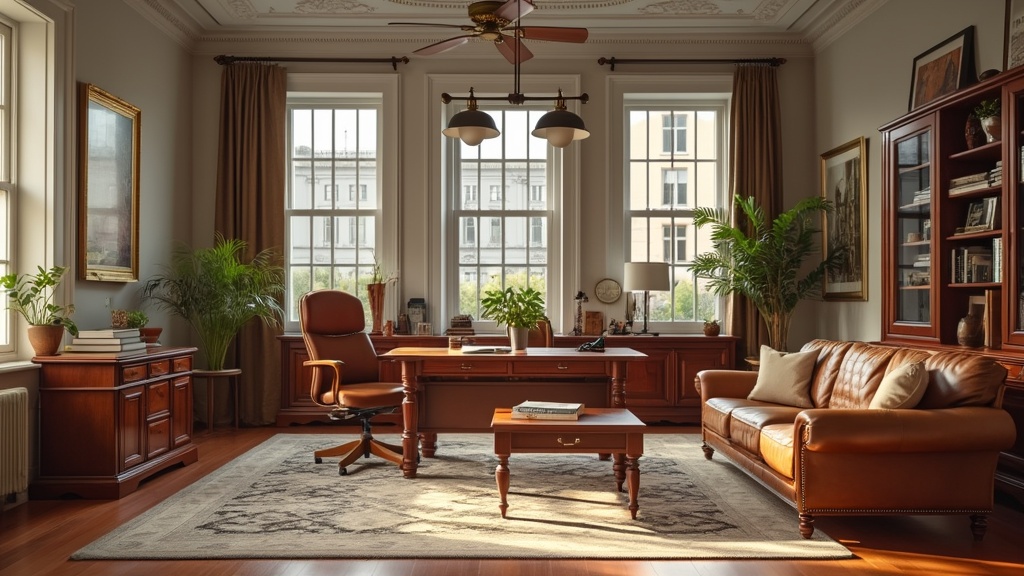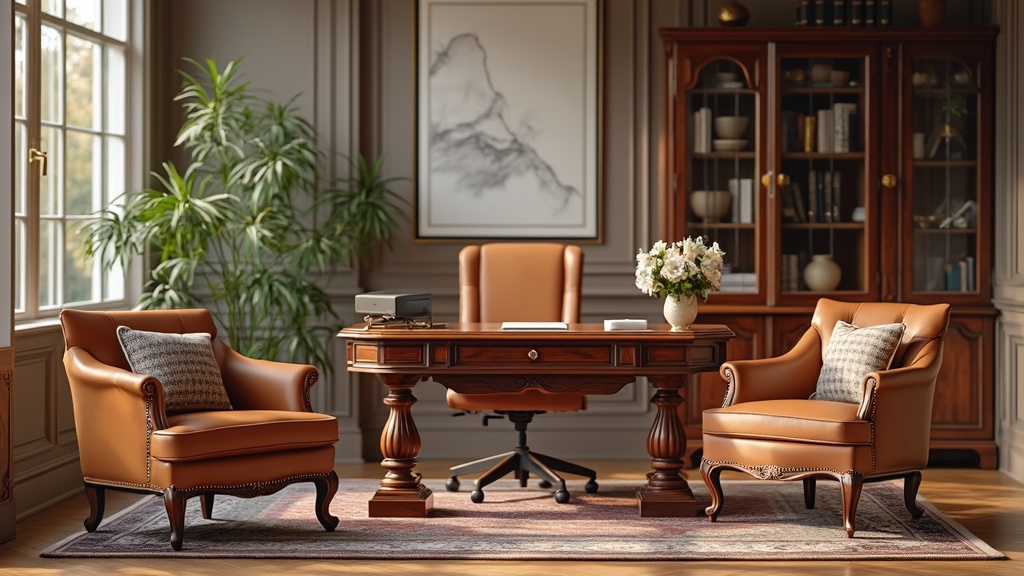British-inspired furniture exemplifies a remarkable blend of tradition and contemporary aesthetics. This unique style articulates a sense of elegance and functionality, showcasing the rich heritage craftsmanship for which Britain is celebrated.
Iconic pieces such as wingback chairs and Chesterfield sofas embody intricate detailing, enhancing the character of any living space.
Quality materials like oak and mahogany are integral to these designs, reflecting a balance of comfort and durability.
Embracing British-inspired furniture allows homeowners to transform interiors into sophisticated spaces, radiating warmth and timelessness.
Click here to learn more about: wholesale home decor
Exploring British Furniture Design
The evolution of British furniture design is rich with historical influences, notably from various periods that have shaped its identity. This evolution highlights distinctive characteristics contributing to its lasting appeal.
Key Historical Influences
British furniture design is deeply influenced by significant historical eras, including:.
- Georgian Aesthetics: Emphasizes symmetry, proportion, and refined elegance.
- Victorian Influences: Introduces elaborate detailing, rich wood tones, and complex patterns that reflect the grandeur of the period.
- Edwardian Simplicity: Focuses on lighter colors and simpler designs, showcasing a shift towards more modern tastes.
Selecting Timeless Pieces
When looking for furniture that embodies these classic styles, consider:
– Handcrafted pieces that showcase traditional craftsmanship.
– Bespoke furniture that allows for customization to meet personal tastes.
– Unique items that reflect the timeless principles of British design, ensuring a connection to heritage craftsmanship.
Selecting pieces that represent the essence of British furniture design not only enhances the aesthetic of a home but also contributes to an enduring legacy of quality and style.
H2 id=header1>What Are Timeless Classic Styles
Timeless classic styles form a strong foundation for enduring design choices. These styles seamlessly blend with modern aesthetics, resulting in distinctive interior spaces that honor historical influences.
They embody the cyclical nature of trends, with several standout styles, including Victorian, Georgian, and Bauhaus, each marked by their defining characteristics.
For example, Victorian design is celebrated for its ornate details and rich fabrics, while Georgian aesthetics focus on symmetry and proportion.
Integrating these classic styles into modern settings can be both effective and visually appealing.
- Consider using vintage British decor as accent pieces.
- Select neutral color palettes to harmonize with bold classic elements.
- Incorporate functional furniture that balances elegance with utility.
By implementing these tips, one can achieve a cohesive environment that showcases the beauty of traditional elegance alongside contemporary styles.
The Allure Of Handcrafted Pieces
The charm of handcrafted pieces captivates those seeking individuality in their decor. This appreciation for heritage craftsmanship has surged recently as consumers prioritize supporting local artisans. Each handmade item inherently tells a story and displays a standard of quality that contrasts sharply with mass-produced alternatives. To find authentic handcrafted pieces that reflect personal tastes, consider the following options:.
Explore local markets and artisan fairs for unique finds that enhance your home decor.
- Reputable online platforms specializing in handmade goods offer convenient access to exceptional items.
- Look for customization options to secure pieces tailored to your preferences.
Incorporating these unique items allows for an aesthetic that fosters both beauty and ethical considerations, ultimately enhancing the overall ambiance of your space.
- Timeless classic styles have been shown to increase property value by appealing to a broader range of buyers.
- Handcrafted items often retain their value better than mass-produced goods, making them a worthwhile investment.
- Studies indicate that incorporating vintage decor can enhance emotional well-being and create a sense of nostalgia.
- Supporting local artisans helps sustain community economies and promotes cultural heritage.

How To Incorporate Vintage Style
Embracing vintage style offers an aesthetic depth that resonates with the growing movement towards sustainable living. Vintage items not only showcase heritage craftsmanship but also contribute positively to environmental efforts by prolonging the use of beautiful pieces.
Key elements defining this style include rich wood tones, intricate detailing, and classic silhouettes, which exemplify the elegance and timelessness of vintage decor.
To effectively source vintage items, explore local thrift stores, flea markets, and specialized online retailers dedicated to classic styles.
Integrating these unique finds with modern home decor enhances both depth and character in your space.
Vintage accessories can seamlessly complement contemporary designs, striking a balance that prevents a cluttered appearance.
Exploring Upholstered Seating Options
When selecting upholstered seating, prioritizing both comfort and aesthetics is essential in achieving a cohesive design. Various upholstery materials such as cotton, linen, and leather provide tailored characteristics for different environments, enhancing the functionality of your furniture.
For example, leather is particularly well-suited for high-traffic areas, thanks to its durability, while cotton and linen thrive in less frequented rooms.
To maintain the integrity of your upholstered furniture, a regular routine of vacuuming and spot cleaning is advised.
Employing protective measures can further preserve the quality of materials, ensuring that your carefully chosen pieces contribute to a cozy ambiance, blending seamlessly with both traditional elegance and contemporary styles in your home.
| Vintage Style Elements | Upholstered Seating Materials |
|---|---|
| Rich wood tones | Cotton |
| Intricate detailing | Linen |
| Classic silhouettes | Leather |
| Timeless elegance | Durability for high-traffic areas |
The Role Of Heritage Craftsmanship
Heritage craftsmanship significantly impacts the furniture landscape, prioritizing quality over mass production. Traditional British furniture design techniques resonate strongly with consumers pursuing authenticity.
A staggering 86% of buyers prioritize craftsmanship when selecting their furnishings.
Heritage brands, recognized for their meticulous attention to detail and use of quality materials, influence market trends, steering preferences towards handcrafted pieces.
Supporting artisans not only strengthens local economies but also preserves invaluable techniques.
To support these artisans, consumers can search for certifications that indicate genuine craftsmanship and favor local artisans.
Choosing vintage British decor enhances modern aesthetics and promotes sustainability, making it a commendable choice for eco-conscious shoppers.
Why Choose Sustainable Options
Making sustainable choices plays a critical role in reducing the environmental impact of furniture production. Eco-friendly materials like reclaimed wood and organic fabrics not only help lower carbon footprints but also contribute to the creation of long-lasting furniture.
Research reveals that 70% of consumers are willing to invest more in environmentally responsible products, indicating a notable shift in purchasing behavior.
Benefits of Sustainable Materials
Opting for sustainable options leads to several key benefits:.
- Reduced waste: Utilizing recycled materials minimizes landfill contributions.
- Healthier environment: Eco-friendly production methods often result in less pollution.
- Quality assurance: Sustainable materials tend to offer better longevity.
Actionable Steps for Consumers
To make informed eco-friendly purchases, consumers should:.
- Seek brands with credible sustainability practices and eco-certifications.
- Embrace a ‘one-in, one-out’ philosophy to minimize waste.
- Consider customization options that reduce material usage.
By applying these strategies, individuals can reinforce a commitment to sustainable living while enhancing their modern home decor.
Heritage Craftsmanship and Sustainability
- 86% of buyers prioritize craftsmanship when selecting their furnishings, highlighting the demand for quality over mass production.
- 70% of consumers are willing to invest more in environmentally responsible products, indicating a shift towards sustainable purchasing behavior.
- Utilizing recycled materials in furniture production minimizes landfill contributions, significantly reducing waste.
- Eco-friendly production methods often result in less pollution, contributing to a healthier environment.
Embracing Cozy Ambiance In Interiors
Transforming a house into a true home begins with crafting a cozy ambiance. Key elements such as lighting and textiles are essential in establishing warmth and comfort.
Soft, ambient lighting—like table lamps and floor lamps featuring warm-toned bulbs—instantly elevates a space.
Enhancing interior design trends with string lights or flickering candles introduces a magical touch.
Layering various textiles, including plush rugs, inviting throws, and elegant curtains, enriches the sensory experience. Fabrics like wool and cotton create a rich tapestry of textures and colors that foster a warm atmosphere.
Choosing earthy tones or pastel hues complemented by deep color accents adds depth and richness, crafting inviting spaces that reflect your style. Integrating modern vintage pieces alongside furniture influenced by Victorian aesthetics and Georgian aesthetics creates a unique palette that resonates with comfort-driven design.
Textures such as plaid patterns or tartan fabrics provide additional layers, enhancing the cozy vibe.
Adopting quality materials, like oak and mahogany, ensures the longevity of crafted furniture, merging practicality with traditional elegance in a contemporary context.
Enhancing Warmth with Textures and Colors
Layering textures and colors is a fundamental approach in achieving a warm and inviting environment.
Utilize a combination of accessory textiles that include throws, cushions, and decorative accents to provide visual interest while promoting comfort. Incorporating handcrafted pieces that showcase heritage craftsmanship adds authenticity and a story to your space, bridging the past with modern sensibilities.
Customizing your approach by selecting unique pieces from local furniture fairs or boutique online retailers can result in a curated collection that reflects personal style. Sustainable options also play an increasingly important role, as ecofriendly choices in furniture design appeal to contemporary sensibilities.
Mixing contemporary styles with traditional elements—such as Chesterfield sofas paired with wingback chairs—fosters a harmonious balance, ensuring that your interiors exude both elegance and comfort.
| Key Elements | Impact on Ambiance |
|---|---|
| Soft Ambient Lighting | Creates warmth and elevates the space |
| Layered Textiles | Enhances sensory experience and comfort |
| Earthy Tones and Pastels | Add depth and richness to the environment |
| Handcrafted Pieces | Add authenticity and a story to the space |



